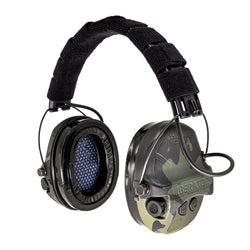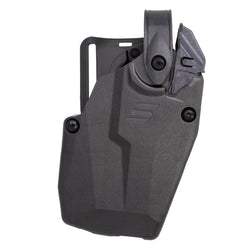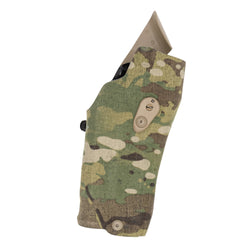The United States Marine Corps bills itself as a Corps of riflemen. An important aspect of Marine Corps culture is the belief that every Marine is a rifleman and every Marine should have a fundamental understanding of how to shoot a rifle. Every Marine must qualify once per year, and their qualification score affects badges on their chest, ranks on their collar, and their personal pride in being a Marine and member of the USMC.
The move to a rifleman’s culture began in the early 20th century when Commandant Major General Charles Heywood discovered that out of 6,000 Marines, only 89 had qualified as marksmen or sharpshooters. The Commandant ordered a regular program for marksmanship to be established and appointed a First Inspector of Target Practice to manage the program.

That culture expanded and grew within the Marine Corps and became a point of pride for Marines. In World War II, the idea of “Every Marine a Rifleman” became part of the core doctrine, and the Rifleman’s Creed became part of the USMC Culture in the 1940s.
The heavy casualties of Marines in the Pacific campaign brought this concept into real life. Marines, regardless of their jobs, were called to fight with the infantry and to fill depleted ranks. That lesson was learned in blood, and it cemented the idea in the mind of the Marine Corps and all Marines who followed.
With the Marine Corps’ 250th Birthday coming in hot, I thought it would be a great time to review the service rifles of the United States Marine Corps.
Early Era
The early era of the Marine Corps encapsulates the Continental Marines and muskets to the early era of bolt-action rifles. There were some radical changes in that short period of time.
Brown Bess
The armories of the Continental military were a bit of a mess with various rifles serving, but if you were a Marine, you likely carried a British Short Land Pattern Musket, also known as the Brown Bess. This smoothbore, muzzle-loading musket was extremely common in the Continental Marine Corps.

Once the newly formed USMC shook off its hangover from Tun Tavern, its birthplace, they grabbed their Brown Bess rifles and hit the high seas, ready to fight the red coats.
Charleville Flintlock Musket Model 1763 and 1777
If you didn’t have a Brown Bess, you likely carried a Charleville Flintlock Musket as a Continental Marine. These were donated by the French to help kill red coats. There’s a joke about French rifles being dropped once, but the French were notable allies of the United States and enemies of the British.
Springfield 1795 Musket
The Springfield 1795 Musket was the first American-made long arm of the newly established United States. It was a copy of the Charleville Musket, and while it wasn’t an original, it jump-started American military small arms production.

Springfield Model 1816 and 1835 Flintlock Musket
The Marine Corps hymn starts with the line, “From the Halls of Montezuma…” This line immortalized the Battle of Chapultepec where 400 Marines stormed the Halls of Montezuma carrying U.S. Springfield Model 1816 and Model 1835 flintlock muskets.
The 1835 Model utilized a percussion cap and allowed Marines to engage much faster than the classic flintlock designs. Marines could fire three to four rounds a minute. The 1816 and 1835 were both derived from the 1816 musket.
Springfield Model 1842
The Model 1842 kept the percussion cap lock and introduced the idea of interchangeable parts. This was a massive breakthrough for mass production. The 1842 would be used on both sides of the Civil War, and some would be converted to rifled designs to accommodate the Minie Ball.
Springfield Model 1855 and 1861
The Springfield Model 1855 was the first rifled musket fielded and therefore the first rifle used by the USMC. The rifle used the Minié ball and fired a smaller .58 caliber projectile. The Model 1855 used the Maynard tape primer, which was intended to replace percussion caps, but the tape proved unreliable.

The Model 1861 kept the rifled barrel and .58 caliber design, but they ditched the Maynard tape design for a standard percussion cap. This rifle was the primary arm of Union forces during the Civil War.
Springfield Model 1873 and 1884 Trapdoor
After the Civil War, it became apparent that metallic cartridges were going to be the future of small arms. The Marine Corps adopted the Springfield 1873 Trapdoor Carbine. These were single-shot .45-70 rifles, and the use of metallic cartridges greatly improved a Marine’s ability to fire quickly and accurately.

The 1884 was an improved version of the 1873 which featured a revolutionary rear sight that allowed the Marines to make use of the enhanced accuracy and precision of the cartridge rifles.
M1895 Lee-Navy
The Marine Corps’ first general-purpose bolt-action repeating rifle was the M1895 Lee-Navy rifle. This straight-pull bolt-action rifle featured an internal five-round magazine and fired the small and fast 6mm round. This would be the smallest cartridge adopted until the adoption of the 5.56.

The USMC expects Marines to be hell-raisers, but if they can get away with it for three years without getting in any trouble, the Marine Corps issues them a Good Conduct medal. The rifle portrayed on that medal is the M1895 Lee-Navy.
Springfield Model 1892-99 Krag-Jorgensen
In an effort to standardize with the Army, the Marine Corps briefly adopted the Springfield Model variant of the Krag-Jorgensen rifle. The Marine Corps used these rifles very briefly and were quickly replaced as the Army adopted a new rifle.
20th Century
The 20th Century moved into a much more modern era of rifles that incorporated extremely fast, hard-hitting cartridges, and repeating rifles became the new standard. Efforts to improve a Marine’s output of fire became one of the primary objectives of arms design.
The Springfield M1903
The Marines traded their Krag-Jorgensen rifles for Springfield M1903 rifles. These bolt-action rifles were based on the Mauser design, so much so that America paid a fee to Mauser. That fee stopped when World War I started.
These were stout battle rifles firing the American .30-06 cartridge. Marines carried these rifles as they made short work of the Huns at Belleau Wood, where legend has it they earned the name Devil Dog.

They served the Marine Corps well and lasted into World War II with the Marine Corps because the Army got all the M1 Garands. Beyond WWII, the M1903 served as a sniper rifle into the Vietnam War with the USMC.
M1941 Johnson Rifles
Before getting enough M1 Garands, the Marine Corps issued limited numbers of the semi-automatic M1941 Johnson Rifle. The Johnson rifle armed Marine Raiders and ParaMarines during the war. It offered a 10-round magazine that could be easily topped off via a M1903 stripper clip.

The Johnson rifle had issues, including vertical stringing, reliability issues when used with bayonets, and small parts that were easy to lose when cleaning the weapon.
M1 Garand
America entered World War II with the big dog of modern battle rifles. While the rest of the world carried bolt-action battle rifles, the Americans carried semi-automatic M1 Garands. Marines were slow to get the M1 due to a short supply.

The Marines were already kicking the Japanese from island to island with ancient M1903s, so imagine how those poor Japanese soldiers felt when facing U.S. Marines armed with semi-automatic, rapidly reloading rifles. The M1 Garand is immortalized in Marine Corps lore by its presence during the iconic flag raising at Iwo Jima.
The M1 Garand continued to serve in Korea until 1957.
M1 Carbine
The M1 Carbine was initially fielded as an alternative to the M1911 to troops who weren’t combat arms troops, but were close to the fighting. The M1 Carbine was lightweight and fired the .30 Carbine cartridge. The low-recoil, lightweight design of the M1 Carbine made it attractive to combat arms troops.

It was popular with mortar men and machine gunners who were already carrying massive crew-served guns. They armed radiomen and Corpsmen, as well as officers and NCOs. The M1 Carbine served throughout World War II and Korea and evolved into select-fire variants and night vision-equipped models.
M14 Rifle
The M14 rifle replaced the M1 Garand, and the goal was to create an M1 Garand with a removable magazine. The rifle chambered the new short-action 7.62x51mm NATO cartridge and offered select-fire capability. The Marine Corps wanted to replace the M1 Garand, BAR, and M3 SMG with one rifle. The M14 was largely a disaster for the U.S. Military and is the shortest-serving service rifle.

M16
The M16 series replaced the M14 and became the longest-serving service rifle in Marine Corps and U.S. History. The M16 mixed polymer and aluminum to create a very light and handy rifle firing the light-recoiling 5.56 cartridge. The M16 had a disastrous premiere thanks to failures of the Department of Defense, but quickly became a well-regarded rifle.

The M16 series evolved into the M16A1, the M16A2, and eventually the M16A4 in Marine Corps service. The Marine Corps often led the charge in modifying the M16 to be a more capable and modern service rifle. The Marine Corps’ obsession with the aspect of “riflemen” meant the M16 remained in service within the Marine Corps longer than the other branches.
It’s likely the M16A4 will remain in Marine Corps armories for years to come, especially amongst reserve, non-infantry Marine Corps units.
Modern Era
The Modern era of the Marine Corps is punctuated by two rifles: one for the Combat Arms portion of the Marine Corps and one for the support elements of the Marine Corps.
The M4A1
The Marine Corps was slow to adopt the M4 series of rifles. The M4 is the carbine version of the M16. It features a shorter 14.5-inch barrel and a collapsible stock. The M4A1 carbine has proven to be a stellar platform for a modern military force.

The M4 served amongst the infantry during the GWOT, but has been pushed to the support forces.
The M27 IAR
The M27 Infantry Automatic Rifle began as a project to replace the M249 SAW with an automatic rifle that offered suppression through superior accuracy. Marine experience with the M27 IAR in combat proved positive, and the Marines pushed the M27 to replace the M16A4 and M4 amongst combat arms forces.

The M27 is a short-stroke gas piston system, and while externally it resembles the M4, it’s a totally different operating system. The HK system has become the standard infantry rifle and is outfitted with the VCOG 1-8X LPVO and Surefire suppressors.
The IAR has evolved into two separate platforms: the M38, a designated marksman variant, and the Reconnaissance Weapons Kit that introduces an 11.5-inch barrel to the M27. The M27 series will arm Marines for future battles both near and far.
From the Halls of Montezuma to the Shores of Tripoli
The Marine Corps will be celebrating its 250th Birthday on November 10, 2025. Marines around the country and around the world will be attending balls, cracking cold ones, and serving or remembering their service as Marines. I want to leave you with the Rifleman’s Creed as we celebrate 250 years of the United States Marine Corps.
The Rifleman’s Creed
This is my rifle. There are many like it, but this one is mine.
My rifle is my best friend. It is my life. I must master it as I must master my life.
My rifle, without me, is useless. Without my rifle, I am useless. I must fire my rifle true. I must shoot straighter than my enemy who is trying to kill me. I must shoot him before he shoots me. I will!
My rifle and myself know that what counts in this war is not the rounds we fire, the noise of our burst, nor the smoke we make. We know that it is the hits that count. We will hit!
My rifle is human, even as I, because it is my life. Thus, I will learn it as a brother. I will learn its weaknesses, its strength, its parts, its accessories, its sights, and its barrel. I will ever guard it against the ravages of weather and damage as I will ever guard my legs, my arms, my eyes, and my heart against damage. I will keep my rifle clean and ready, even as I am clean and ready. We will become part of each other. We will!
Before God, I swear this creed. My rifle and I are the defenders of my country. We are the masters of our enemy. We are the saviors of my life.
So be it, until victory is America’s and there is no enemy, but peace!









